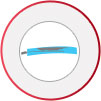Intermittent Claudication
Intermittent claudication is a condition characterised by pain and/or cramps in the lower leg muscles while walking and is relieved during rest. This type of pain that comes on with exertion and disappears with rest is referred to as intermittent claudication. When walking and exercising, the calf muscles need more oxygen to function, but the reduced blood flow does not carry enough oxygen. The pain may be felt as a dull ache or throbbing feeling.
When you present to our clinic with these symptoms, the diagnosis of claudication is made by a combination of clinical examination and a wide range of imaging tests (ultrasound, CT and MRA scans), and also by measuring and comparing blood pressures in the leg and arm (ankle-arm index).
Rest Pain, Ulcers and Necrosis
Rest pain is when the patient experiences pain in the legs especially the toes of the feet at all times. The pain is often worse at night time when trying to sleep with the legs up in the bed. These symptoms are a progression from intermittent claudication as the arterial disease advances and the blood supply to the legs is severely reduced. Often patients have to use very strong medications to get relief from pain symptoms. Minor knocks and bruises in the feet may struggle to heal due to the lack of adequate blood supply and nutrition. These then become ulcers and the tips of the toes may turn black (necrosis). Rest pain, ulcers and necrosis combined with reduced pressures (ABI) in the legs is referred to as Critical Limb Ischaemia(CLI). CLI is an indicator that the blood supply to the leg is severely depleted and here invasive intervention is warranted on an urgent basis to ensure that the leg does not deteriorate any further.




